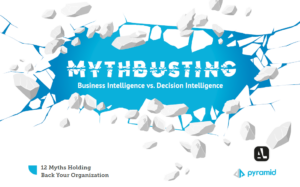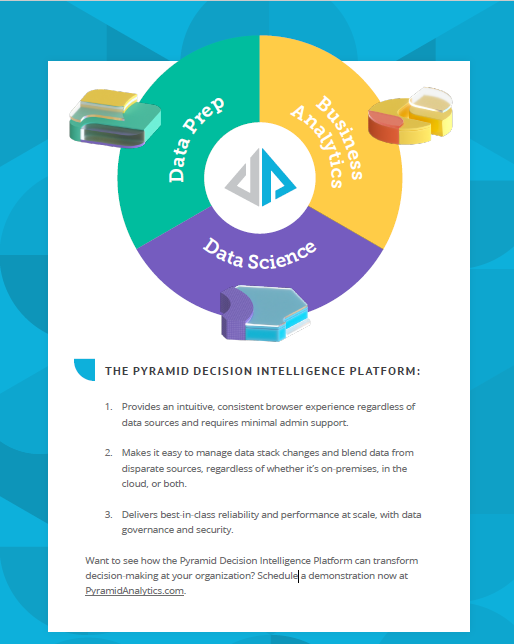Mythbusting - Business Intelligence Versus Decision Intelligence
Introduction
For decades, BI and analytics tools provided organizations with reports, dashboards, and visualizations against data warehouses or in-memory data stores. But in most organizations, business people — from the C-Suite to the frontline — remain highly dependent on technical teams for their reports and dashboards. They rely on a wide range of systems, integrations, workarounds, and “key persons” to access the data they need to create reports and dashboards. The process is complicated and time-consuming and only serves to make intelligent decisionmaking
more difficult.
Why does traditional BI fail to deliver value in the world we operate in today? And why do organizations continue to invest in multiple fragmented tools that require specialized technical skills that only make things worse? We believe it boils down to several myths, or widely accepted
“truths,” that are born from the limitations of today’s BI tools. These myths aren’t wrong as much as they are outdated. Because there is a better way. Today we have decision intelligence, what’s next in analytics. Decision intelligence turns many critical limitations of BI and analytics on its head.

In this guide, we cover some of the most widely held beliefs about data and analytics today. We’ll show you how, with a new approach, you can move past these limiting beliefs to take your analytics to the next level and get on a faster path to growing revenue, boosting productivity, saving time and money, identifying new revenue streams, and reducing complexity and risk.

Business Intelligence Vs. Decision Intelligence
Business Intelligence (BI)
What is it?
Business Intelligence (BI) and analytics pertain to various tools, programs, technologies, and practices used to collect, integrate, measure, analyse, and present raw data to generate insightful, valuable, and actionable business information. Organisations use BI and analytics tools to understand their data to make better decisions. Whether centrally administered or decentralised, BI and analytics tools have been adopted broadly at most mid-sized and large organisations and are considered effective tools in all kinds of businesses.
The Promises of BI and Analytics
- Gather data from internal and external sources.
- Prepare data for analysis.
- Design and run inquiries against the data.
- Produce reports, dashboards, and data visualisations.

Decision Intelligence
What is it?
Gartner defines decision intelligence as “a practical approach to improving organisational decision making,” which “models each decision as a set of processes, using intelligence and analytics to inform, learn from, and refine decisions.”
Decision intelligence is what’s next in analytics. It addresses the shortfalls of current fragmented approaches that frustrate the leaders responsible for data and analytics strategies. It is designed to help innovative leaders catapult their organisation’s data and analytics capabilities to the next level along three key dimensions: data, people, and analytical capabilities, from the simple to the sophisticated.
Simply put, decision intelligence enables data and analytics leaders to empower any person in their organisation — from the C-suite to the front line and everyone in between — with the insights they need to make faster, more informed decisions, even if they don’t have a technical background in analytics or data science.
The Promises of Decision Intelligence
- Create more compelling and relevant data stories.
- Don’t delay insights because IT has to move data into a central repository.
- Reduce the backlog of requests for reports, dashboards, and data extracts.
- Accelerate the adoption of insight-led decisions by everyone from the C-suite to the front line by delivering tailored access to the insights needed to answer questions and take action.
- Meet requests for capabilities from the simple to the sophisticated, empowering anyone from a data novice to a data scientist to be self-sufficient.

Data is exploding. The volume of data generated, consumed, copied, and stored is projected to reach more than 180 zettabytes by 2025. In 2020, the total amount of data
generated and consumed was 64.2 zettabytes. (Source: Statista).
The tremendous growth rate in data can either be a hindrance or a help to organisations looking to gain a competitive advantage from their data and analytics investments. Many believe the only way to deal with the volume of data is to spend endless amounts of time wrangling data from disparate sources, replicating it, bringing it into a single place, and parsing it into bite-sized data sets so it can be analysed.
Instead, organisations must be able to instantly connect to any data source directly, query, and blend any amount of data. But is it even possible? This section breaks down commonly held beliefs about data management and shows you how to use any data within your organisation for better decision-making.
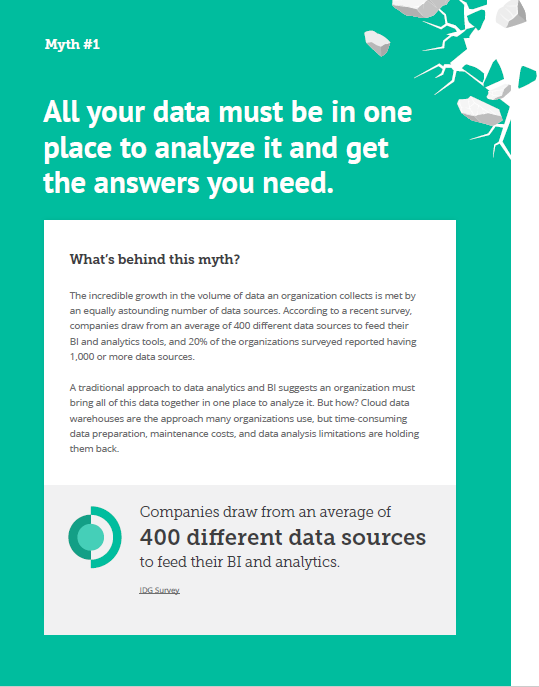
Why do people believe this?
- Typical BI tools require data to be brought into a single standardised format to ensure consistency.
- Consolidating data into a single place is the only way to use it to enable faster, better decision-making.
- Having data in one place is the only way to see trends and compare data across the enterprise.
Truth:
Leave your data where it is.
While there will always be a role for data warehouses featuring highly curated data, volumes are growing exponentially. It is becoming difficult — if not impossible — to keep up with the near-constant requirement to prepare the data for analytics consumption. For your organisation to truly get the most out of its data, regardless of how complex your environment is, leave the data where it is and bring your analytics platform to your data instead. To achieve this, look for a platform that can directly query the data, no matter where it is.
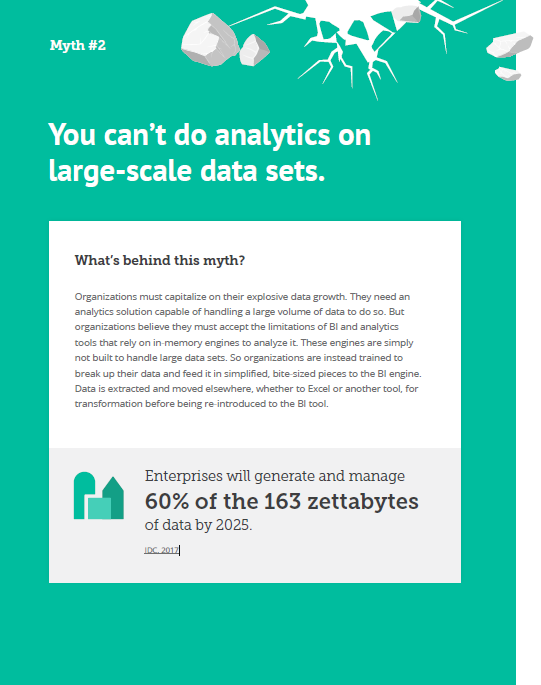
Why do people believe this?
- Most analytics tools are limited to handling data they can access directly
from a single data source or data that has been extracted from its original
source and blended to create a single data set. - Analytics tools crash or run slowly when working with large data sets.
- Most analytics tools have data upload limits that require people to break up
large-scale data sets.
Truth:
You can do analytics in place.
While in-memory engines can handle more minor, less complicated data sets, they can’t keep up with larger ones. So why use in-memory engines? You can do analytics on large data sets with the right type of analytics engine: one that can directly query the data where it is.

Why do people believe this?
- Most BI tools cannot integrate data from multiple sources into a
single dashboard view.
Truth:
You can integrate disparate data into a single dashboard.
Data from one source alone is not always enough. Insights come when data intersect, revealing new perspectives. To see beyond the obvious, you must be able to integrate data from multiple sources, wherever that data resides — Amazon Redshift, SQL Server, Excel, wherever.
The truth is it’s possible to integrate governed data into a single dashboard with the right platform. With the right decision intelligence platform, anyone can display disparate data sources they have managed access to on a dashboard. And better yet, be capable of filtering, slicing, and dicing across that data without duplicating or extracting it to a separate location. That’s where you get unexpected answers.
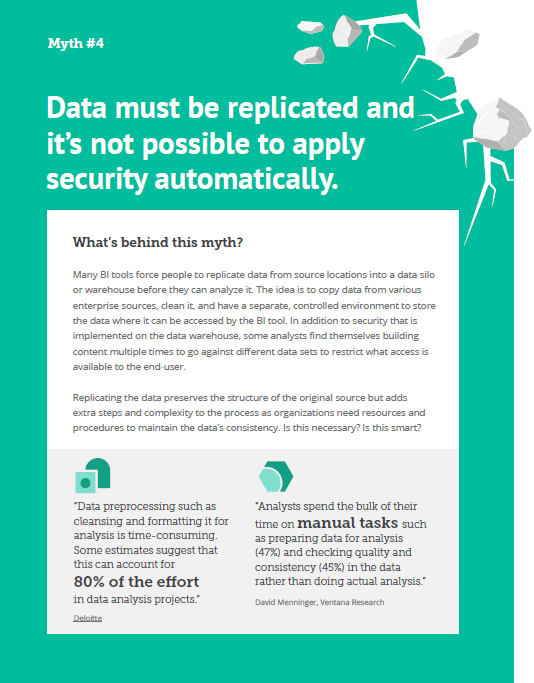
Why do people believe this?
- Organisations are told that replicating data keeps it consistent, reliable, and up to date.
- Typical analytics tools are built to pull from a data warehouse instead of straight from the data source, claiming this improves the speed and efficiency of the data analysis.
- Organisations are encouraged to avoid working directly with source data to preserve it.
Truth:
There’s no need to replicate data for decision intelligence.
Data replication is a widely accepted strategy for disaster recovery, but when it comes to analytics, it increases risk. Replicating your data and moving it to another location loses its inherent security and, depending on the way the data is shared (extracted into intermediate files and transferred via email or other insecure means, etc.), can inadvertently introduce additional downstream security concerns (e.g., data getting into the wrong hands). Plus, you risk creating copies of the data that conflict with the source data (data silos). Data latency is another concern: the moment it’s extracted from the source, it’s no longer up to date. Leave the data where it is and avoid the unneeded chaos.
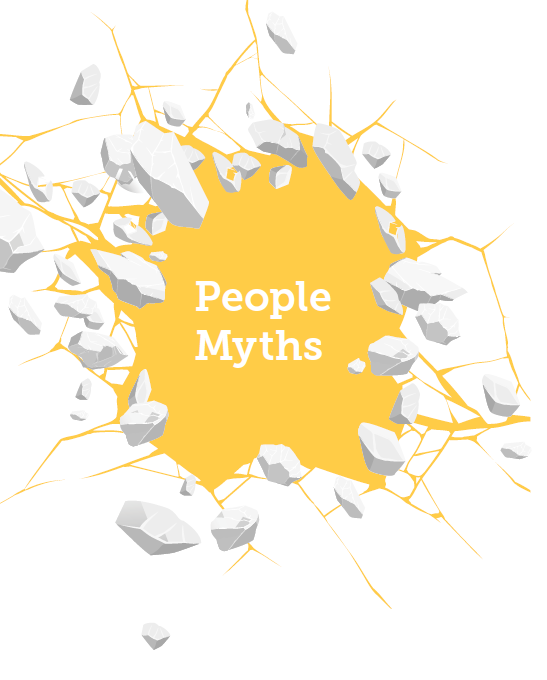
The promise of BI and analytics conjures up images of business leaders and managers peering into rich dashboards, orchestrating data-driven strategies, and driving innovation. In reality, many organisations are surprised to learn that usage rates drop surprisingly low after investing in a months-long analytics project and experiencing the initial excitement. That’s because it’s not enough to offer “self-service business intelligence.” Systems are still too fragmented, causing mistrust in data and chaos in decision-making.
There are many reasons why self-service analytics and BI technology are falling short, but there are fewer reasons to continue living with the shortcomings. With DI, organisations can benefit from a no-code, point-and-click browser experience that empowers any person, from the novice to the data scientist, to make data-driven decisions.
In this section, we break down commonly held beliefs about data and analytics accessibility and look at how today’s AI-driven analytics solutions can put data into decision-makers hands across the organisation.
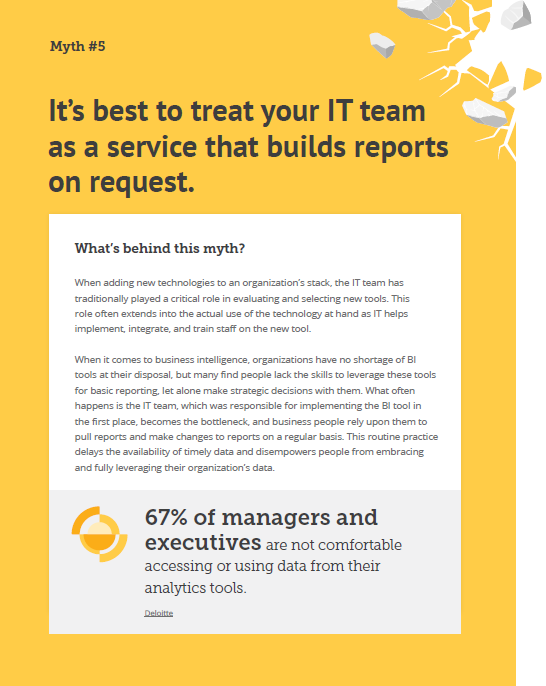
Why do people believe this?
- IT teams use BI and reporting tools the most, and many people are content to stay with the status quo.
- The only way to standardize reporting is to centralize the function, and IT is a natural choice for the job.
- Traditional BI requires IT to pull in-house data to generate reports because the data is not readily available, and the systems are not in place to disperse it.
Truth:
Analytics can live where decisions are made.
Your IT team brings significant value as administrators and managers of the data and analytics stack. They are in charge of balancing data security and access and optimizing infrastructure investments to manage costs. Why distract them from their core mission by having them spend countless hours manually producing and reproducing reports? The creation and upkeep of the reports should be with the business, the place where decisions are made. The right type of analytics platform allows business people to be self-sufficient, accessing and preparing data for analysis independently, without having to wait for IT.
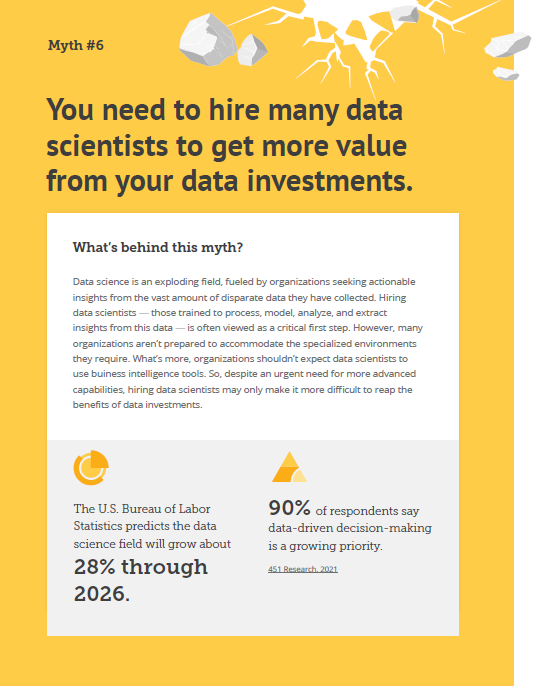
Why do people believe this?
- The challenges of integrating exploding data stores are so significant that people believe hiring data scientists is the only way to deal with the challenge.
- People feel pressure to make decisions faster and think that data scientists can make sense of their data more quickly.
- Most tools are too technical to be used by managers and leaders with traditional skill sets.
- People believe data is too complex to be analyzed and interpreted by people who lack specific training.
Truth:
Citizen data scientists are here.
While data scientists will surely add value to your organization in the long run, gone are the days when data science was reserved exclusively for data scientists. Now an entire generation of business workers is expected to use data in their daily roles. These citizen data scientists, armed with domain knowledge and a strong desire to use data to drive their decisions, can, in some cases, prevent the need to hire pedigreed data scientists. In many cases, they can be just as effective as data scientists as long as they have access to a solid foundation of data and analytics capabilities.

Why do people believe this?
- People believe BI tools are too complex and time-consuming for everyone to learn
and use. - People worry that the widespread use of existing BI tools will cause data to be
misused or misinterpreted. - There is a lack of resources to train decision-makers to use existing tools.
Truth:
The right platform will scale.
Yes, the reports of low levels of analytics adoption are accurate. But that’s only for
organisations that are using the wrong tools! Widespread adoption of analytics
and BI is indeed possible on a platform. By centralising data access in a governed
location and giving anyone — regardless of skill — analytics experiences that
adapt to their needs, organisations can scale analytics beyond the few to the
many. Decision intelligence can be extended to all people in the organisation to
make better decisions in their unique roles.
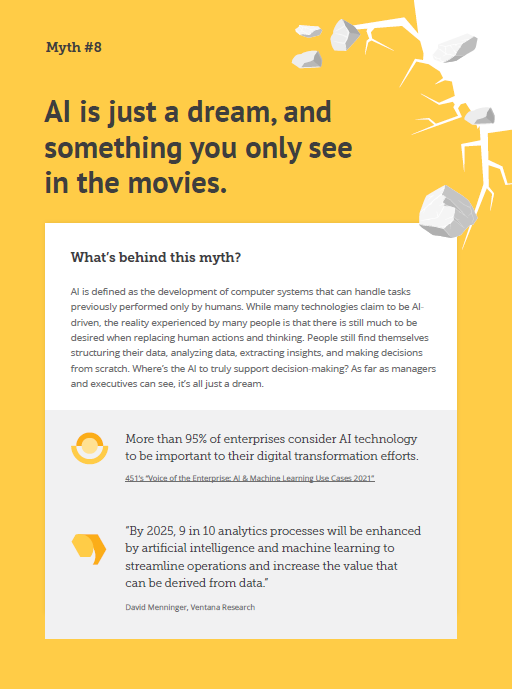
Why do people believe this?
- Business intelligence tools don’t deliver clear insights to drive fast, informed decision-making.
- A lot of human interaction is still required to extract and organise data for use within BI tools.
- BI tools are still too complex for many executives and managers to use, requiring technical know-how to produce meaningful analytics.
Truth:
The right AI-driven capabilities will support
everyday decisions.
The knock against AI is that it can’t provide real value to day-to-day decisions. It’s a myth! The trick is to expose AI in ways that support everyday business challenges — not sit apart. With the right platform, AI and intelligent tools can help even the most non-technical people in your organisation be more productive and gain business insights. How? AI can be brought into everyday analytics scenarios with the right software.
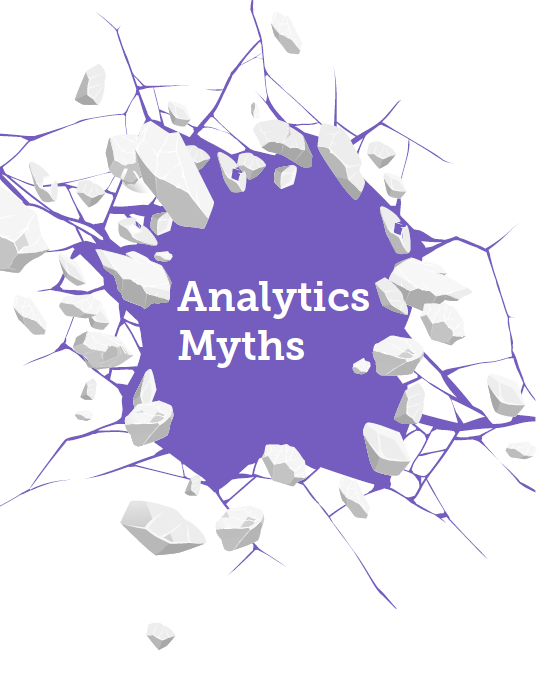
So far, we’ve covered some of the top business intelligence myths related to data and people. But one more category of myths gets to the core differences between business intelligence and decision intelligence and underscores how organisations are being held back by current tools. The next four myths relate to the analytics tools organisations use to retrieve and combine data for analysis.
A recent FinancesOnline report found that improved efficiency and productivity (63%) and faster, more effective decision-making (57%) are the top benefits companies get from using analytics. Shouldn’t these numbers be higher? It turns out that among the top reasons organisations say they are held back from more effective use of analytics are data privacy and security concerns (49%), limited access to data (33%), lack of training (29%), and the feeling that analytics solutions are not user-friendly (28%).
The myths we dispel in this section will reveal the possibility of combining data prep, business analytics, and data science into a single unified platform that would allow for sophisticated analytics and data science without writing a line of code — with governance and security built-in.
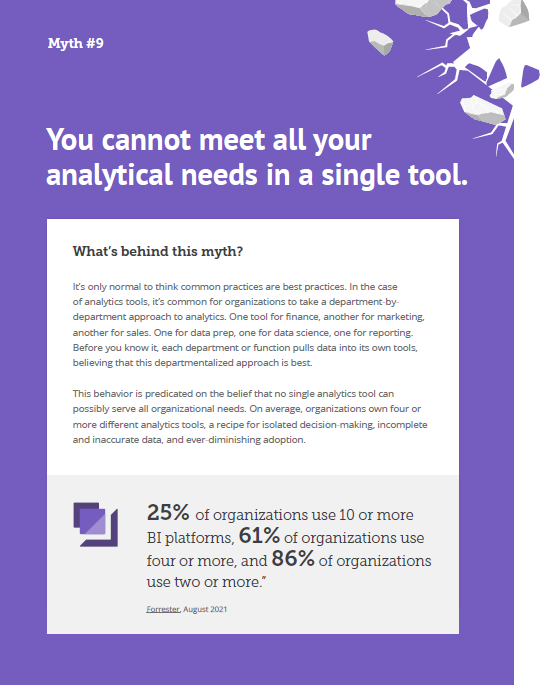
Why do people believe this?
- People in different departments and functions (sales, finance, product) require their own specialised analytics tools.
- For many, this is the way it’s always been done and, therefore a default “best practice.”
- Analytics tools lack the all-in-one functionality necessary to combine data prep, data science, and reporting.
Truth:
A decision intelligence platform provides complete
capabilities to meet your needs.
While a departmentalised, best-of-breed approach is an effective strategy in some areas of a modern business, analytics is an exception. In fact, trust in data erodes when you have several data prep tools, standalone data science workbenches, and numerous analytics and reporting tools for different people in different departments. With a decision intelligence platform — which is purpose-built to combine all three capabilities and functions in one single, unified solution — you don’t need all those separate tools. What’s more, with decision intelligence, you can get a no-code point-and-click experience where everyone, from data novices to data scientists, can get value from the data analytics experience.

Why do people believe this?
- With so many analytics and BI vendors on the market, it’s hard to discern the true differentiation from one tool to another.
- People figure the vendor they trust for another critical aspect of their business must also be the best analytics vendor.
Truth:
Tools are the same; a decision intelligence platform
delivers insights for everyone.
Data analytics is an exciting field filled with innovation, yet it isn’t easy to discern true vendor differentiation. But there are apparent differences when you compare tools versus platforms. BI and analytics tools solve departmental needs and are designed primarily for users with technical skills. A platform enables broad but governed data access, promotes analytics adoption with tailored capabilities intended for different people, and provides ready access to the data needed to make decisions. A decision intelligence platform takes it even further: adding data science capabilities and integrating AI guidance and automation to show different analytical perspectives quickly. A decision intelligence platform is anything but a commodity: it’s purpose-built to help an organization grow revenue, reduce costs, and boost productivity.
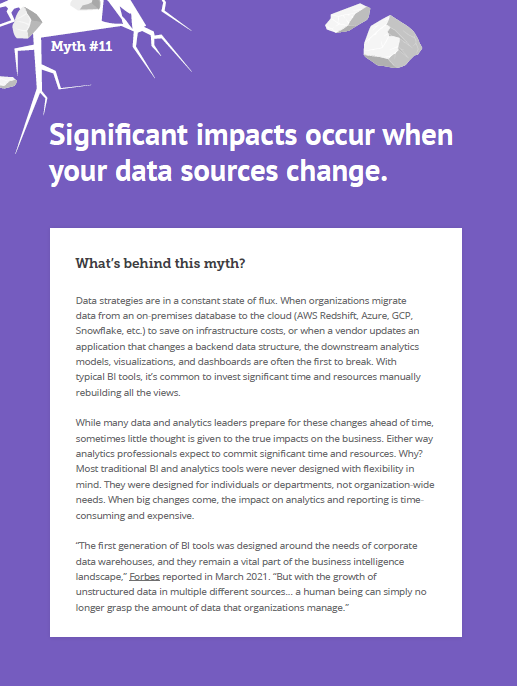
Why do people believe this?
- With data strategies changing all the time, organisations have come to expect significant impacts to the business (and downstream analytical content such as dashboards and reports) as a fact of life.
- Most BI and analytics tools were designed to solve individual or departmental problems, not organisation-wide data infrastructure needs.
Truth:
When you separate data from your analytics with a
semantic layer, you can reduce the impact of IT and
data changes on your business.
When it comes to your data and analytics, change doesn’t have to be hard. Avoid using analytical tools that weren’t designed with enterprise-wide needs — and inevitable changes — in mind. When you separate data from analytics from the data via a virtual semantic layer — a vital capability of a decision intelligence platform — you can insulate your organisation from broad changes to the data strategy. Using functionality purpose-built to accommodate and manage change, the downstream impacts to business reporting can be minimised — and an organisation is free to pursue a holistic data strategy that focuses on the needs of the whole enterprise.
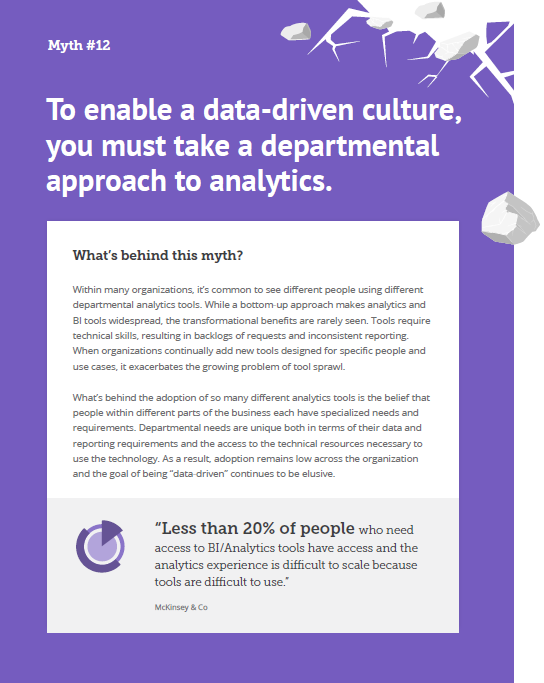
Why do people believe this?
- Everyone needs analytics, but people are led to believe analytics is not for everyone to use.
- Organisations often lack a strategic, organisation-wide approach to BI and analytics.
- People in departments make decisions about the analytic capabilities they need and see no reason to approach this differently.
Truth:
A platform can serve all needs, from the simple to
the sophisticated.
If you want to enable a data-driven culture quickly, you need to take a more strategic, organisation-wide approach to analytics. The truth is everyone needs insights, not just the expert few, regardless of where they sit within the organisation.
While each type of person has individualised analytics needs, they shouldn’t rely on point solutions with limited scope and enterprise reach. By taking a strategic approach to analytics and choosing a unified platform purpose-built for people with different needs, organisations can reduce reporting backlogs, produce consistent reporting, and extend analytics across the organisation. This helps organisations grow revenue and identify new revenue streams; reduce cost, complexity, and risk; and boost productivity by saving time and money.
Take the Next Step
Shape your decisions with the Pyramid Decision Intelligence Platform.
Many leaders believe using data-led insights for decision-making is mission-critical. At
Pyramid Analytics, we believe in making it easy to provide insights for everyone. We enable BI and analytics leaders to manage and tailor access to insights for any person inside and outside the organisation so they can answer questions, collaborate, and take action. With the right analytics platform in place, no data source, data-driven intelligence, or AI-enabled insight needs to be off-limits to any person, no matter their background or skill set.
A Purpose-Built Platform
Pyramid is what’s next in analytics. Our unified decision intelligence platform delivers insights for everyone to make faster, more informed decisions. It provides direct access to any data, enables governed self-service for any person, and serves any analytics need in a no-code environment. The Pyramid Decision Intelligence Platform uniquely combines Data Prep, Business Analytics, and Data Science in a single environment with AI guidance, reducing cost and complexity while accelerating growth and innovation. Flexible deployment options include on-premises, public, private and hybrid cloud, and multi-cloud environments.

